When people talk about Germany in the 1920s, they usually conjure up images of shopping at the baker’s made with wheelbarrows full of money, or think of children playing with paper castles made from wads of banknotes, or of queues in front of stores to buy as many goods as possible. Indeed, in the years of World War I, Germany was hit by severe inflation, which stabilized for a while around 1920 and then ran rampant again, becoming hyperinflation in 1923. In fact, an extremely unfavorable economic situation began in 1914 with Germany’s abandonment of the so-called gold standard (the “gold system”), i.e., the convertibility of currency into gold: in a state where the gold system is in force, an amount of currency circulates equal to the amount of gold stored in the central bank’s reserves. The measure was adopted to finance the war: Germany, unlike France, which financed itself by increasing taxation, planned to meet war expenses by issuing new debt (the German government was convinced that it could repay it, and thus return to prewar normality, by winning the war: the plan was also to restore the gold standard at the end of the conflict). Shortly before the war, along with the Goldmark, the currency in force under the gold standard system, Germany began issuing a banknote, the Papiermark, which was non-convertible and guaranteed with state assets. The abandonment of the gold system, which had ensured price stability throughout Europe in the early twentieth century, was heavily criticized even then because it was believed that it would lead to a sharp devaluation of the mark, which in fact occurred on time: the amount of money that the German central bank put into circulation to meet war expenses already led to steep price hikes in the years of the conflict, so that by 1920 the cost of living in Germany was already nine to ten times higher than in 1914 (if before the war it took 4 marks to buy a dollar, by June 1920 it was up to 40 marks per dollar).
The problem, however, lay in the fact that Germany lost the war, and not only had the strategy of the country’s government (which in the meantime had changed its form of government: the German empire had been transformed into the fragile Weimar Republic, named after the city where the constituent assembly was held) proved unsuccessful, but the Germans were saddled with new debts, on top of all those of war reparations that the victors imposed with the Treaty of Versailles: 132 billion Goldmark, which was about three times German GDP, to be paid in installments of two billion a year with gold or foreign currency, plus 26 percent of the annual value of German exports: under these conditions, it was assumed that Germany would pay off the debt in forty-two years. Germany’s need to buy foreign currency caused the amount of Papiermark in circulation to increase, thus reinvigorating the inflationary impulse, and by October 1921 the exchange rate with the dollar had risen to 180 marks. Reparations were then compounded by the many social benefits that Germany had to pay after the conflict. Germany’s strategy was to print money, with the result that already by the fall of 1922 it took 4,500 marks to buy one dollar, and Germany had declared itself unable to meet the reparations. Thus, in January 1923 France and Belgium occupied the Ruhr, the country’s most industrialized area, as collateral: the occupation only accelerated the crisis, since Germany secured financial support for workers who decided not to work so that the fruits of their labor would not leave the country. And hyperinflation became uncontrollable: at the beginning of January 1923 it took 6,890 marks for one dollar, and by the end of the month the exchange rate had risen to 48,390 marks for one dollar. And then again to 193,500 in June, to 11.4 million in August, to peak in November 1923, when more than 4.2 trillion marks were needed for one dollar.
The mark, in essence, was depreciating day by day, which meant that one had to spend the money one earned immediately lest, as early as the next day, it was worthless. And of course, the very strong demand for basic necessities, which everyone wanted to buy before the Papiermark depreciated further (or they were bartered), continually aggravated the situation. Hyperinflation destroyed savers (and of course made saving impossible), since few were able to liquidate their assets to invest in gold or safe-haven currencies, and it came down on all fixed-income earners (wage earners, employees, retirees) and then later on the self-employed who could no longer find a clientele to pay for their services. “Inflation,” wrote Adam Fergusson, author of one of the best-known studies of German hyperinflation in 1923, “aggravated every problem and destroyed any possibility of national revival or individual success, and finally produced the very conditions that enabled extremists on the left and right to raise the masses against the state, pitting class against class, race against race, family against family, husband against wife, worker against worker, town against country. Inflation subtly undermined national compactness just when need and necessity could have acted as a catalyst and stimulus. Because of its discriminatory and profoundly unfair nature, it caused everyone to give the worst of themselves, workers and industrialists, farmers and laborers, bankers and shopkeepers, politicians and bureaucrats, housewives, soldiers, merchants, miners, loan sharks, pensioners, doctors, trade unionists, students and tourists, even the latter. It aroused fear and insecurity among people who had already known too much of it, fostered xenophobic feelings, encouraged contempt for government and revolt against law and order. It made corruption work where this was unknown and sometimes, too many times, where this should have been considered impossible. It constituted the worst of the preludes to the Great Depression (though distant chronologically from it) and the events that followed.” A climate of great uncertainty and distrust spread (aggravated by the fact that a large part of the German population did not understand why what was happening was happening, and in such situations it is easy to try to lay the blame on scapegoats), poverty increased considerably, and so did unemployment and crime.
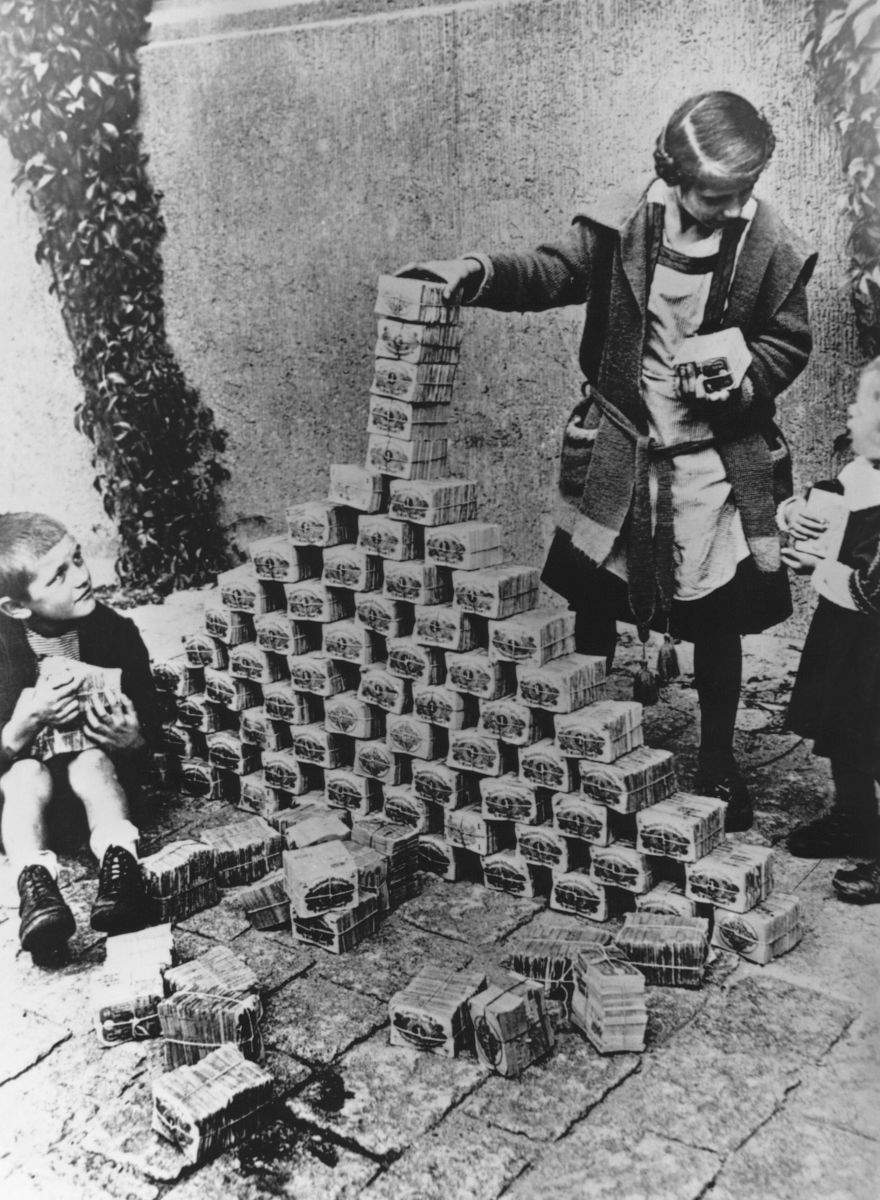 |
| Germany, 1923: children making paper castles out of bundles of banknotes |
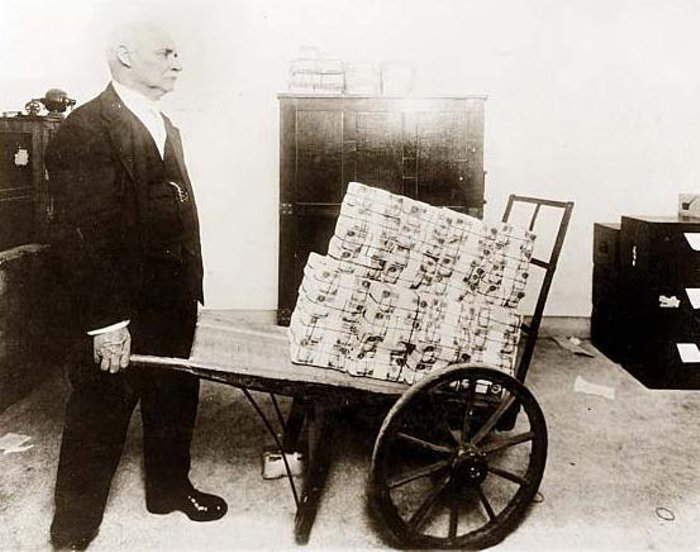 |
| A cart used to transport money |
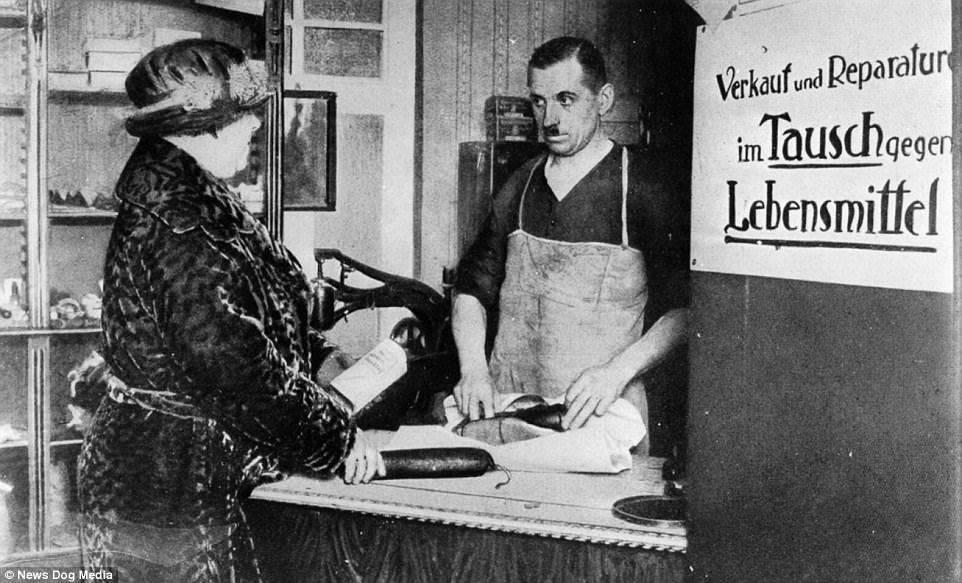 |
| A shoemaker’s sign in 1923 Germany asking for payments by barter: “Purchases and repairs in exchange for basic necessities.” |
Theart of the time did not stand by and watch what was happening, and there were many artists who reacted. One of the most obvious reactions was satire, and in this sense one of the most famous works is a cartoon by illustrator Erich Schilling (Suhl, 1885 - Gauting, 1945), published in November 1922 in Simplicissimus magazine, a popular humor periodical founded in 1896 and which lived until 1967. The protagonist of the illustration is the inventor of printing, Johannes Gutenberg, who watches in dismay as a printing press takes on anthropomorphic guise and throws thousands of thousand-mark sheets over a throng of hands that look almost animal-like so voracious, hooked and in some cases withered with hunger. Seeing this vile spectacle, Gutenberg can do nothing but put his hands in his hair, observe everything in amazement and exclaim, “Das habe ich nicht gewollt!” (“I did not want this”). Schilling’s intent is clear: to point out how an instrument, the press, that was born to guarantee people freedom, has turned into the main symbol of a kind of economic apocalypse, into a monster spewing worthless pieces of paper. In literature, a similar image can be found in a 1937 novel by Hans Fallada (Greifswald, 1893 - Berlin, 1947), Wölf unter Wölfen (“Wolf among Wolves”), set in hyperinflationary Germany: “Somewhere in the city there was a machine that, day and night, spewed paper over the city and the people. They called it ’money’: they printed figures on it, nice, sharp figures with lots of zeroes, which got rounder and rounder. And when you had worked and sweated to put a little aside for your old age, it all became worthless paper, waste paper.”
Among the most prolific illustrators of the time was Karl Arnold (Neustadt bei Coburg, 1883 - Munich, 1953), author of some of the best-known satires on hyperinflation, also published in Simplicissimus magazine. One of the most violent dates from 1923 and is entitled Papiergeld! Papiergeld! (i.e., “banknote,” “paper money”), and depicts a mother exhausted by poverty who, under a shower of banknotes, lifts a skeletal child now consumed by hunger. It is, scholar William Coupe has written, “perhaps the most memorable of all commentaries on human suffering connected with galloping inflation that had gone completely out of control.” Another scathing satire was the one Arnold drew for the November 1923 cover of Simplicissimus, a kind of summary of the winners and losers of the hyperinflation crisis. Four panes show the treasures of as many actors in the crisis: the church, the crown, black market dealers, and ordinary people. The first three panes show large accumulations of material wealth (works of art, weapons, jewelry, luxury goods), while the fourth shows the bodies of a man and two children, dead of hardship, as they float among the banknotes. The cover plays on the assonance between the nouns “Gold” (gold) and “Geld” (money), illustrating the four boxes with as many expressions: “Kirchengold” (“Church gold”), “Kronengold” (“Crown gold”), “Schiebergold” (“Gold of the traffickers”) and “Papiergeld” (“Paper money”).
Some artists directly addressed the theme of the social consequences of hyperinflation. These include one of the most important exponents of the Neue Sachlichkeit (the “New Objectivity” of German art after World War I), Otto Dix (Gera, 1891 - Singen, 1969): the Morgan Library in New York has a famous drawing of his, entitled Wir wollen brot! (“We want bread!”), from the inscription that appears on the sign carried by a group of poor protesters. It is a work from 1923 that, as is often the case in Dix’s art of the 1920s, focuses on the severe imbalances in German society at the time: on the one hand, the middle class and the poor affected by inflation (in the crowd of protesters we find a diverse humanity: workers, a pregnant woman, a pensioner, an invalid), on the other hand the rich, portrayed with the usual grotesque connotations that often characterize them in Dix’s works, who do not feel the blows of inflation because they have already taken care to secure their wealth and repay their domestic debts with now worthless currency (as often happens in situations of severe economic upheaval, there are also those who come out greatly enriched), and can therefore gobble merrily. One of the rich, moreover, wears the Nazi swastika on the lapel of his jacket: the NSDAP, the National Socialist German Workers Party, had been born only three years earlier, in 1920, but Dix was already well aware of the political force that was profiting from the social chaos. Perhaps the most tragic work, however, is a print by a woman, Käthe Kollwitz (Königsberg, 1868 - Moritzburg, 1945), titled Das Letzte (“The Last Thing”), which renders with distressing clarity the tragedy of savers who had seen the money they had saved in a lifetime of work go up in smoke and pensioners who had found themselves without a livelihood: the gloomy protagonist of the scene is a man, his face disfigured (the crisis has reduced him to a kind of beast), who, in an empty and miserable room, finds suicide as the ultimate solution.
 |
| Erich Schilling, Das habe ich nicht gewollt! (illustration in Simplicissimus magazine, November 15, 1922) |
 |
| Karl Arnold, Papiergeld! Papiergeld! (illustration in Simplicissimus magazine of June 15, 1923) |
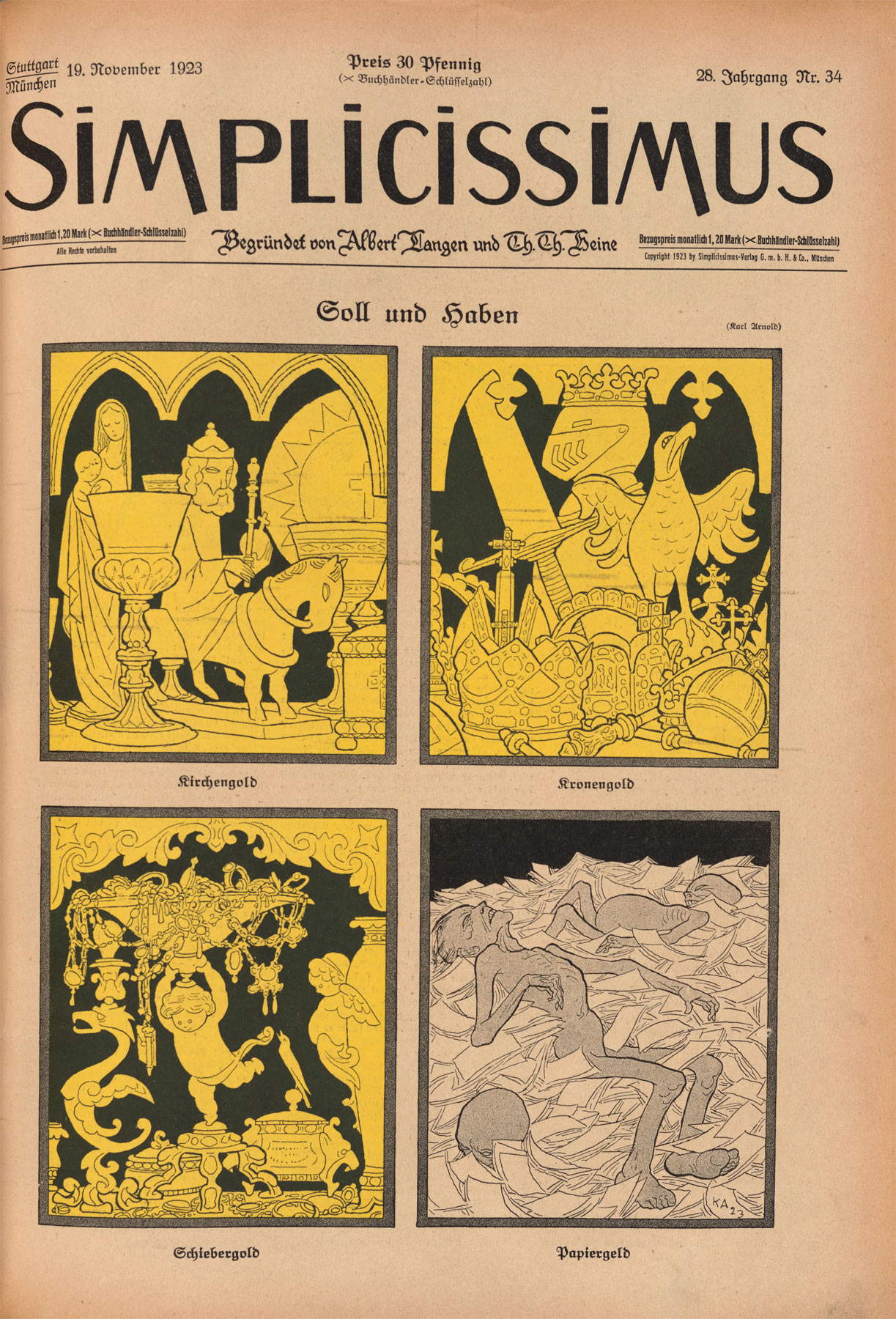 |
| Karl Arnold, Sold und haben (cover of Simplicissimus magazine of November 19, 1923) |
 |
| Otto Dix, Wir wollen Brot! (1923; pencil and ink on paper, 38.7 x 42.6 cm; New York, The Morgan Library) |
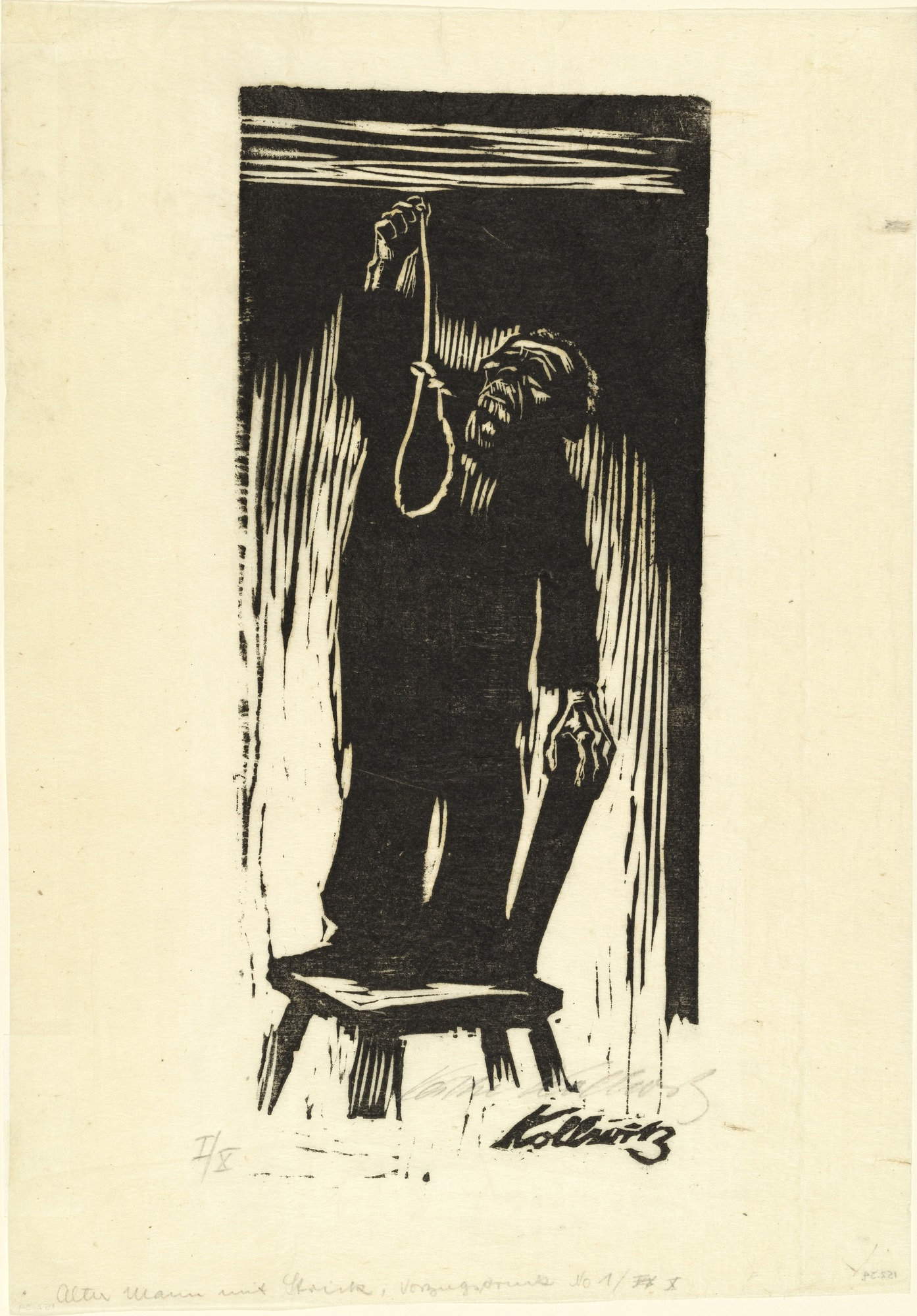 |
| Käthe Kollwitz, Das Letzte (1924; woodcut, 29.4 x 12.8 cm; New York, The Metropolitan Museum) |
Scholar Dennis Crockett also analyzed the state of the art market during the hyperinflation crisis. As is often the case in times of uncertainty, works of art by the most recognized artists became assets to invest in, which led to fervent art market activity already in the years immediately following the end of World War I. Luxury goods, and works of art were included in this roster, sold with relative ease (so much so that in December 1919 the government imposed a tax on precisely luxury goods, but exempted works made by living or recently deceased artists, provided they were purchased directly from the artist or an immediate family member). The market calmed down in the years of relative price stabilization, between 1920 and 1921, and then resumed vigor in 1922: in such a crisis those who owned goods and got rid of paper money benefited, with the result that purchases continued into the period of hyperinflation. Artists who sold abroad were favored: Crockett recalls that, for example, Franz Radziwill, in October 1923, managed to sell two paintings in U.S. dollars, and a few days later, with the proceeds, he was able to buy a house, given the devaluation of the mark. However, there were also downsides for artists working in Germany: the materials for oil painting were very expensive, and above all, this medium of expression was time-consuming; if one wanted to maximize profits, one had to be fast, which is why the art of hyperinflationary Germany is basically art on paper. Some artists purposely sought to raise scandals in order to gain market recognition: this was the case, for example, with one of the greatest artists of the time, George Grosz (Berlin, 1893 - 1959), who exploited this mechanism extensively. “Since the beginning of inflation,” Crockett writes, “the work of art had assumed a new status, that of an object of real value, like jewelry or automobiles, and for many the art market had become a substitute for the stock market. Artworks on the market were risk-free investments for speculators if they were made by artists who enjoyed a reputation, and reputation was not limited by talent.” Buyers were typically wealthy people who did not care much about quality. Speculation favored the artists, who were able to enrich themselves greatly: the market thus became populated with improvised collectors, concerned only with the economic value of the works, and with works of poor quality. There was a return to normalcy only in 1924, when the crisis was over, when sales dropped and the market slowly began to repopulate with real collectors.
The paintings related to the inflation crisis are not many, since on current events the artists of the time preferred to express themselves, as we have seen, through cheaper means or in a position to reach a wider circulation, but it is also possible to read the events in Germany at the time through some more “noble” works than those seen so far. Sometimes the crisis enters the works through a back door, as is the case in a work by Otto Dix preserved at the Metropolitan in New York, the portrait of entrepreneur Max Roesberg, holding a paper flyer: this is a sheet printed on the cheap pink paper that was used during the crisis as a very low-cost material. The gap between the rich and the poor is then the subject of a 1921 watercolor by Georg Scholz (Wolfenbüttel, 1890 - Waldkirch, 1945), Arbeit Schändet (“Ashamed to Work”), in which a rich, fat industrialist rides by in his car looking almost amused at a worker passing in the street with his son.
Finally, other artists, partly because they were driven by exigencies, resorted to the collage technique using ... current currency! Art historian Erin Sullivan Maynes recalled the experience of László Moholy-Nagy (Bácsborsód, 1895 Chicago, 1946) and Kurt Schwitters (Hanover, 1887 - Ambleside, 1948), who between 1922 and 1923 found themselves sharing the same studio in Berlin’s Spichernstrasse: the two artists worked without turning on the heat because they could not afford it. But that was not the only thing their earnings could not support: “We had no money to buy paints or canvases,” Moholy-Nagy would later recall, “so Kurt urged me to follow his example and use the money as an everyday material for collages.” The Israel Museum in Jerusalem preserves one of Moholy-Nagy’s earliest collages, 25 Pleitegeler (“25 Vultures of Bankruptcy”), where the outline of the bird of prey that gives the work its name looms over the black silhouette of a man (who for Moholy-Nagy is thus the real vulture, more than the bird in flesh bones and feathers), and all around newspaper clippings and banknotes describe the situation well (the “25” that recurs obsessively in the work, taken from banknotes but also from newspapers, refers to the exchange rate at the time when the collage was made, namely 25 million marks for one dollar). Schwitters also used money in his work: for example, in an untitled work from about 1925 preserved at the Los Angeles County Museum we find the fragment of a Notgeld, the emergency banknote, covered with geometric fragments so that the inscription “one hundred thousand marks” is evident.
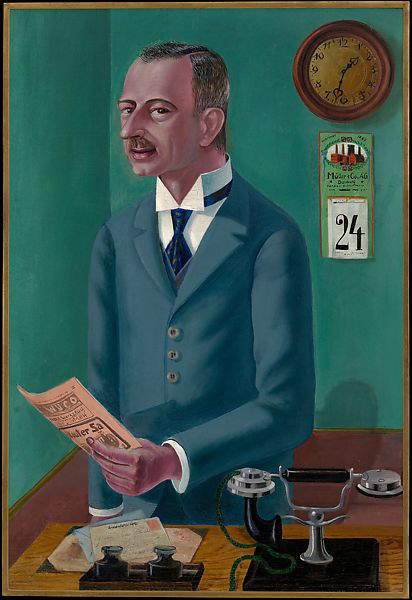 |
| Otto Dix, Portrait of Max Roesberg (1922; oil on canvas, 94 x 63.5 cm; New York, The Metropolitan Museum) |
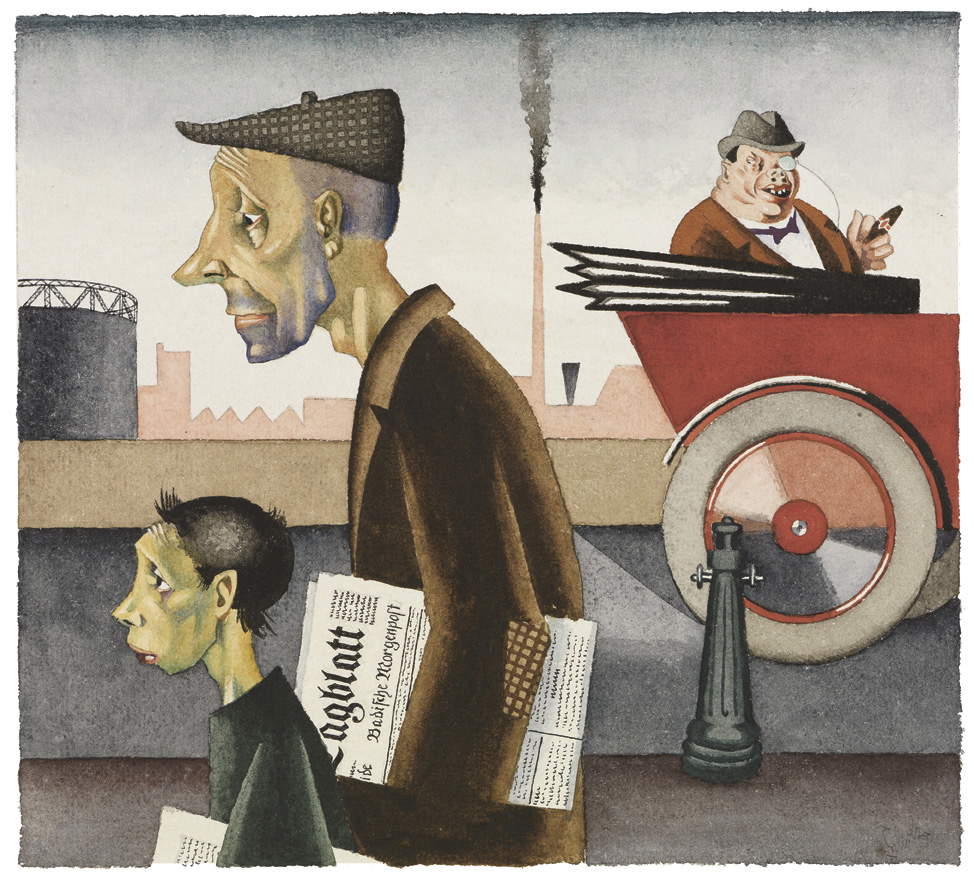 |
| Georg Scholz, Arbeit Schändet (1921; watercolor on paper; Karlsruhe, Kunsthalle) |
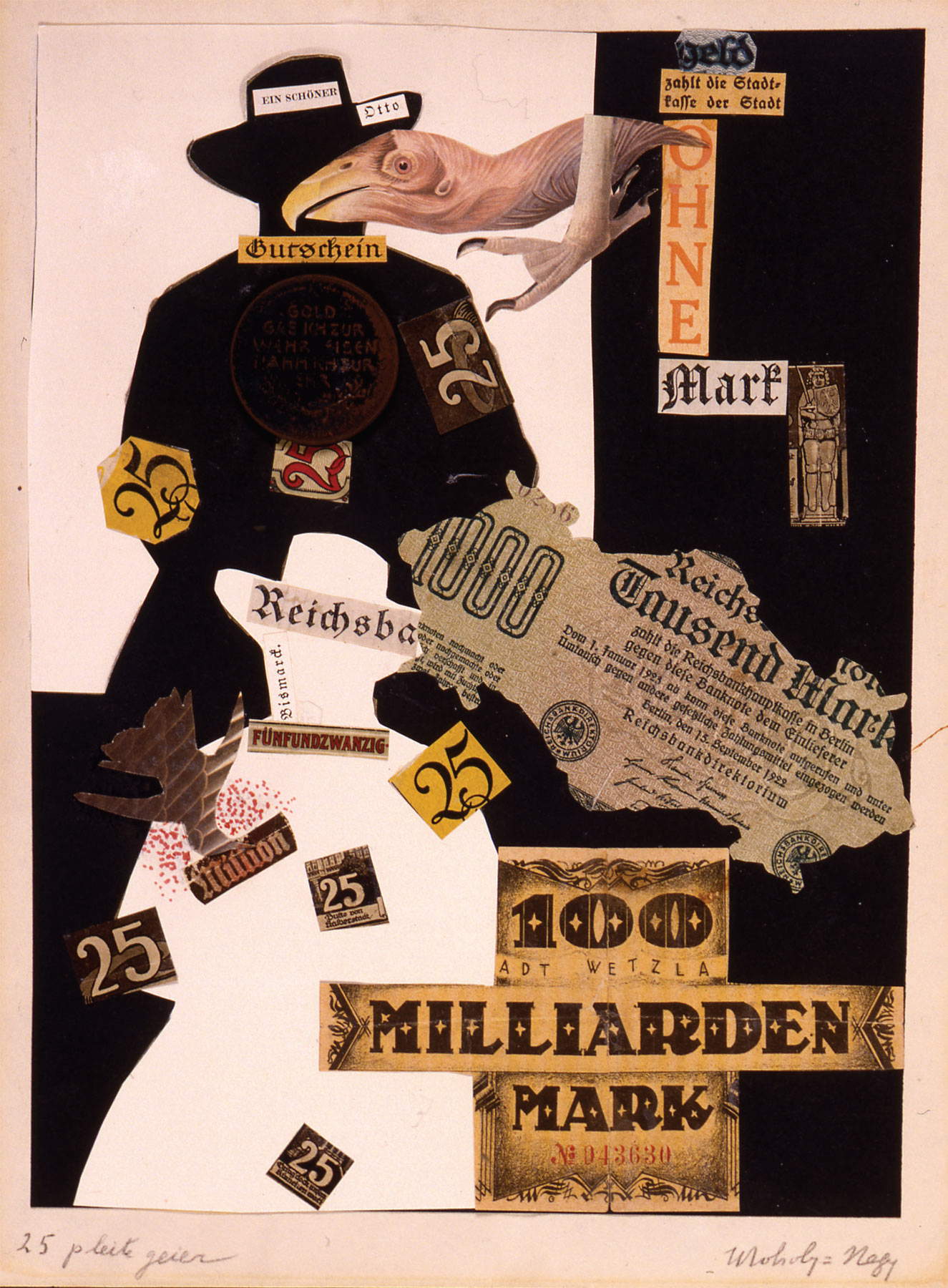 |
| László Moholy-Nagy, 25 Pleitegeier (192223; collage on paper, 30 x 23 cm; Jerusalem, The Vera and Arturo Schwarz Collection of Dada and Surrealist Art in the Israel Museum) |
 |
| Kurt Schwitters, Untitled (One Hundred Thousand Marks) (c. 1925; collage on paper, 12 x 9 cm; Los Angeles, Los Angeles County Museum of Art) |
The hyperinflation crisis was resolved beginning in late 1923, when politician Hans Luther became finance minister in mid-October and economist Hjalmar Schacht was appointed, on November 12, president of the Reichsbank, with the specific goal of ending hyperinflation. The stabilization plan called for the Reichsbank to be prohibited from issuing new government bonds, and for the creation of a new bank, the Deutsche Rentenbank, which would issue a new currency, the Rentenmark (“annuity mark”), secured through real assets, such as land for agricultural or industrial use. The assets to secure the currency issue were valued at 3.2 billion Goldmark, and an equal amount of Rentenmark was issued to replace the Papiermark, with the exchange rate set at 4.2 Rentenmark per U.S. dollar (the exchange rate of the mark before the war). The idea was successful due to the fact that, unlike the Papiermark, the Rentenmark was pegged to real existing assets and consequently loans were secured with mortgages on real assets. An austerity policy was then initiated, which had further devastating consequences for employment, but with these measures, and with the resulting reliance on the new transitional currency, Germany succeeded in its intent to stop the inflationary vortex and stabilize prices.
Is a crisis like the one that rocked Germany in the 1920s still possible in today’s world? Technically, yes: it has happened recently in Argentina (in 2019 it ended the year with inflation at 53.8 percent: thus not at the levels of the Weimar Republic, but still a strongly sustained rate), Zimbabwe (one of the worst cases in history: inflation that had become unsustainable to the point that the African country’s government, in 2008, suspended the use of the country’s currency) and Venezuela (where in December 2019 inflation touched a disastrous 9,600 percent rate). In the economically stronger countries, however, this is an unlikely scenario: central banks aim to keep prices at acceptable levels precisely to avoid a recurrence of similar scenarios (Article 127 of the Treaty on the Functioning of the European Union states that the main objective of the European System of Central Banks is precisely to maintain price stability), and the ECB Governing Council aims to keep inflation at levels below 2 percent over the medium term. Today’s economic strategies should therefore avert dangers of too high inflation.
Essential Bibliography
Warning: the translation into English of the original Italian article was created using automatic tools. We undertake to review all articles, but we do not guarantee the total absence of inaccuracies in the translation due to the program. You can find the original by clicking on the ITA button. If you find any mistake,please contact us.